You might not know that refill price can swing 2–3x depending on tank size and gas mix, not just supplier. You’ll want specific numbers because an 80 cf argon refill often runs $60–$70 while a 300 cf C25 mix can be about $125, and smaller CO2 tanks sit near $60. Knowing how size, gas type, lease vs. purchase, and local rates affect per-hour cost will help you pick the cheapest option—here’s how.
The Cost Breakdown for Filling Welding Gas Cylinders
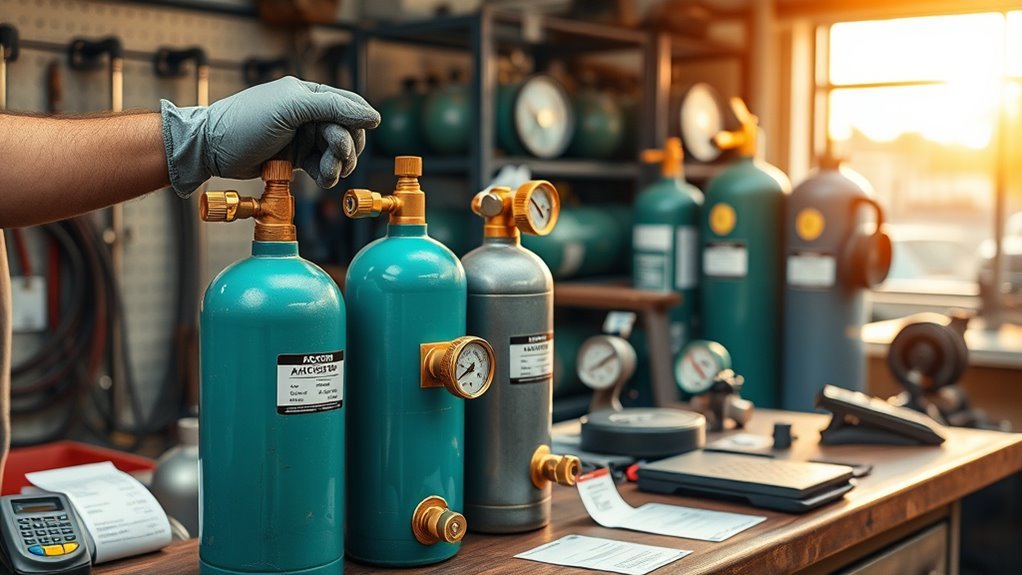
Price is the primary variable when you refill a welding gas cylinder, and costs can differ sharply by tank size, gas mix, and supplier. You’ll find typical refill pricing clustered: an 80 CF argon runs about $60–$70, a 125 CF near $70, and a 40 CF roughly $60, so purchasing larger capacity reduces refill frequency and lowers per-cubic-foot cost.
A 300 CF C25 mix (75% Ar/25% CO2) can cost around $125 to refill, reflecting blend and volume differences. Supplier comparison is essential: local independents may charge as little as $23 for small-tank refills, while national chains often bill higher rates and may add HAZMAT fees per refill that greatly raise your total spend.
You should calculate effective cost per CF, include recurring HAZMAT surcharges, and project annual refill frequency against upfront tank choices to determine the most economical procurement and refill strategy for your welding operations.
Common Types of Welding Gas and Their Prices
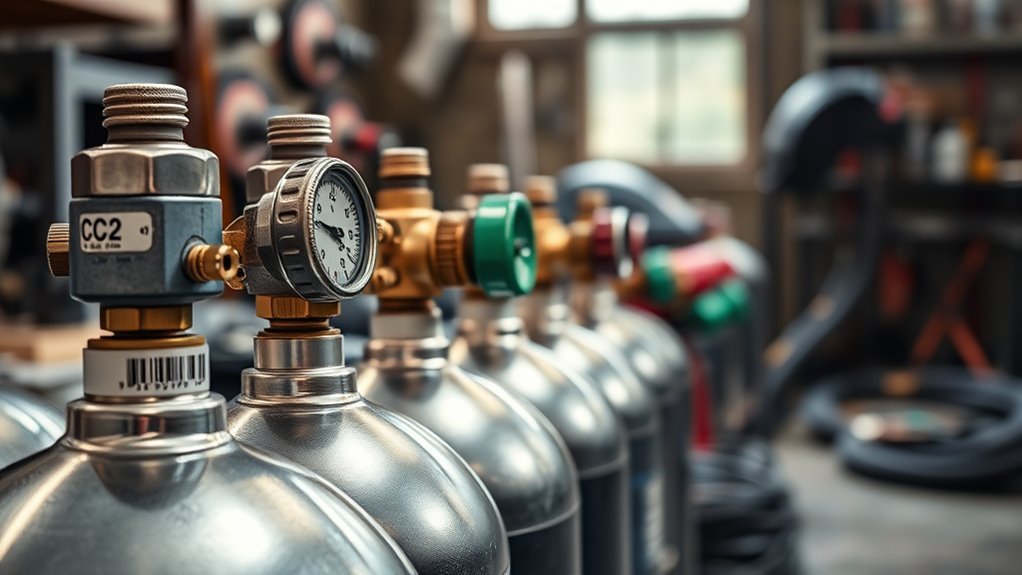
You’ll compare common gases — argon for TIG, C25 for MIG, and acetylene for oxy-fuel — and their typical uses and costs.
Expect refills like $60 for a 40 CF argon, about $70 for 80–125 CF options, $125 for a 300 CF C25, and $85–$225 for acetylene depending on cylinder size.
Also weigh tank capacity versus per-fill price and shop around local independents versus chains to minimize recurring refill costs.
Gas Types and Uses
When choosing shielding and fuel gases, weigh performance against refill cost so your process stays both efficient and economical.
You’ll select gases by gas properties and welding techniques: argon (TIG) gives clean arc control and costs about $70 for an 80 CF refill.
C25 (75% argon/25% CO2) balances weld pool stability for MIG and costs roughly $125 for a 300 CF refill.
CO2 is the low-cost option for MIG, about $60 for a 40 CF refill, but increases spatter versus inert mixes.
Helium delivers deeper penetration for TIG and is the costliest refill—price varies by supplier—yet boosts travel speed on thick sections.
Acetylene fuels oxyacetylene systems, averages near $150 per standard tank refill, and remains essential for cutting and brazing.
Tank Sizes and Prices
Pick the right tank size to control your per-cubic-foot cost: common options are 40, 80, 125 and 300 CF, with full-tank purchase prices typically about $230 (40 CF) up to $400 (125 CF) and refill costs roughly $60 (40 CF), $70 (80–125 CF) and about $125 for a 300 CF refill—making the 300 CF most economical for high-volume use.
You’ll see gas-specific price variance: 100% argon fills run roughly $90 for 125 CF, while C25 in 300 CF can be about $125. Shop local suppliers; independent shops sometimes undercut chain rates.
Factor tank maintenance and compliance with safety regulations into lifecycle cost: hydrostatic testing, valve upkeep, and proper storage add predictable, budgetable expenses that affect total cost-per-CF over the tank’s service life.
Refill Costs and Options
Anyone shopping for refills should compare per-fill and per-cubic-foot rates across gases and tank sizes to control operating costs: expect about $60 for a 40 CF refill, roughly $70 for 80–125 CF bottles (making those sizes more economical per CF), and around $125 for a 300 CF C25 fill.
Full 125 CF argon purchases have jumped into the several-hundred-dollar range—so local supplier quotes (which can sometimes be as low as $23 for small refills) and gas type (argon vs C25 vs specialty mixes) will materially affect your cost-per-CF and total welding budget.
You’ll choose refill options based on duty cycle, mixture needs and transport logistics.
Contact local suppliers for spot pricing, volume discounts and cylinder exchange programs to minimize operating expense.
Tank Sizes, Purchase Vs Lease, and Upfront Costs
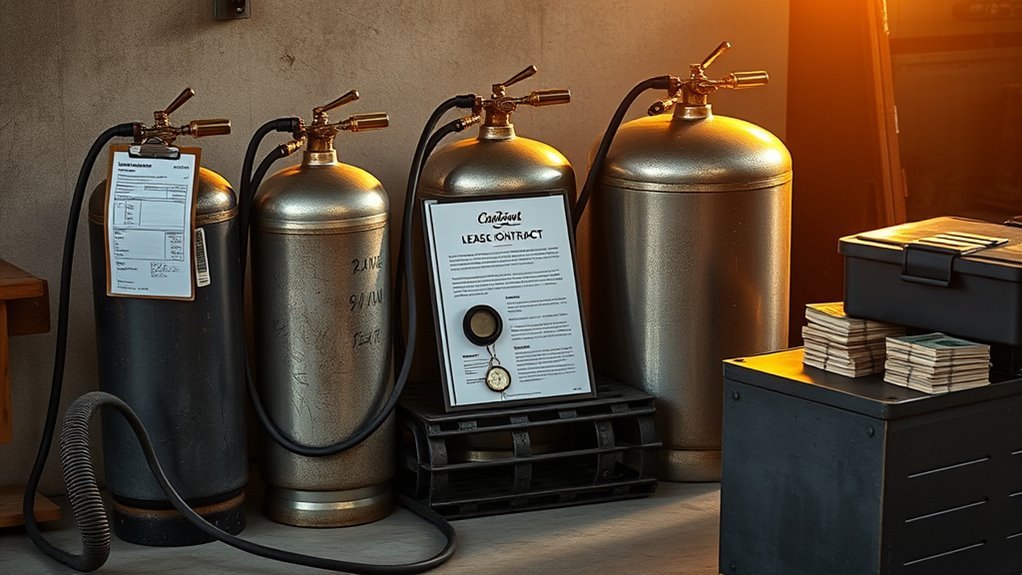
Although tank sizes and acquisition methods vary, you’ll normally choose between cylinders from about 20 CF up to 300 CF, and that choice drives both upfront outlay and per-fill economics.
You’ll see an 80 CF tank retailing roughly $290–$320 and a 125 CF around $350–$400; used tanks can drop initial cost to about $100.
Tank leasing and purchase benefits each matter: leasing (≈$75/yr for a 150 CF) lowers immediate cash needs and shifts maintenance/liability to the supplier, while owning avoids recurring lease fees and lets you shop multiple refill sources.
Leasing (≈$75/yr for 150 CF) reduces upfront cost and supplier liability; buying avoids lease fees and allows refill shopping.
Compare total upfront plus expected refill spend to decide: a larger tank increases capital but reduces cost-per-CF at refill (80 CF refill ≈ $70; 125 CF refill ≈ $70 yields better per-CF value).
Factor regional price variance and local supplier competition when estimating real-world acquisition and refill budgets.
Typical Refill Frequencies and Ongoing Expenses
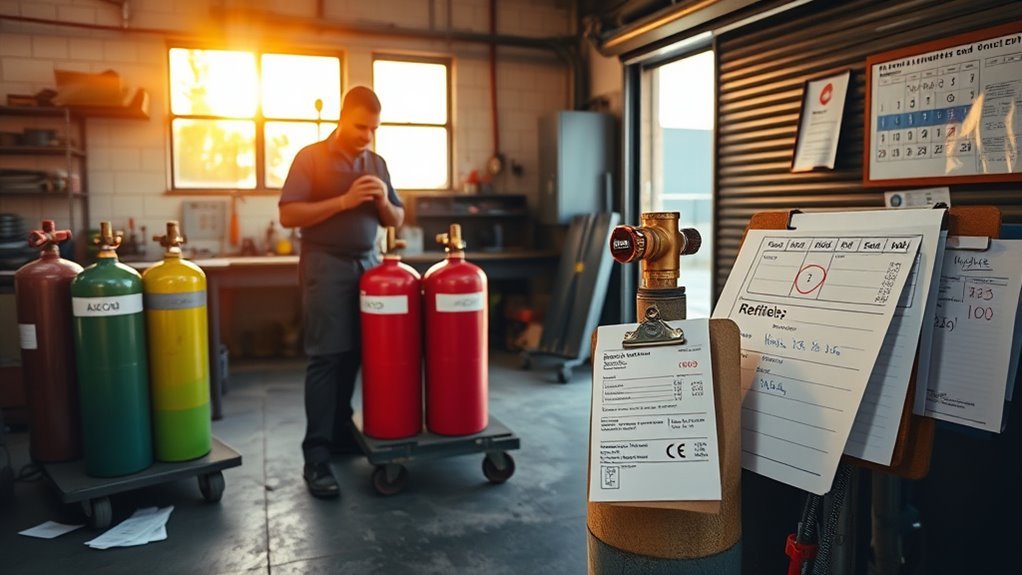
Because refill frequency directly drives your operating budget, you need to plan around tank size, flow rate and supplier fees.
Smaller tanks like a 40 CF typically cost about $60 per refill but require more frequent turns, raising annual spend via increased service trips and HAZMAT surcharges. An 80 CF refill is roughly $70; at 10 CFH it yields about eight hours of welding, so your daily usage pattern dictates how often you reorder.
A 125 CF also runs near $70 and can stretch to quarterly refills for light use, lowering labor and transport overhead.
For cost management, factor first-year capital outlay—an 80 CF can total about $660 including purchase and initial refills—then expect ongoing annual refill costs near $360 for regular use.
Add supplier fees and occasional emergency fills to reserves. Monitor actual consumption rates and negotiate volume discounts or bundled service to reduce per-refill impact on operating expenses.
How to Calculate Cost Per Hour of Welding Gas Use
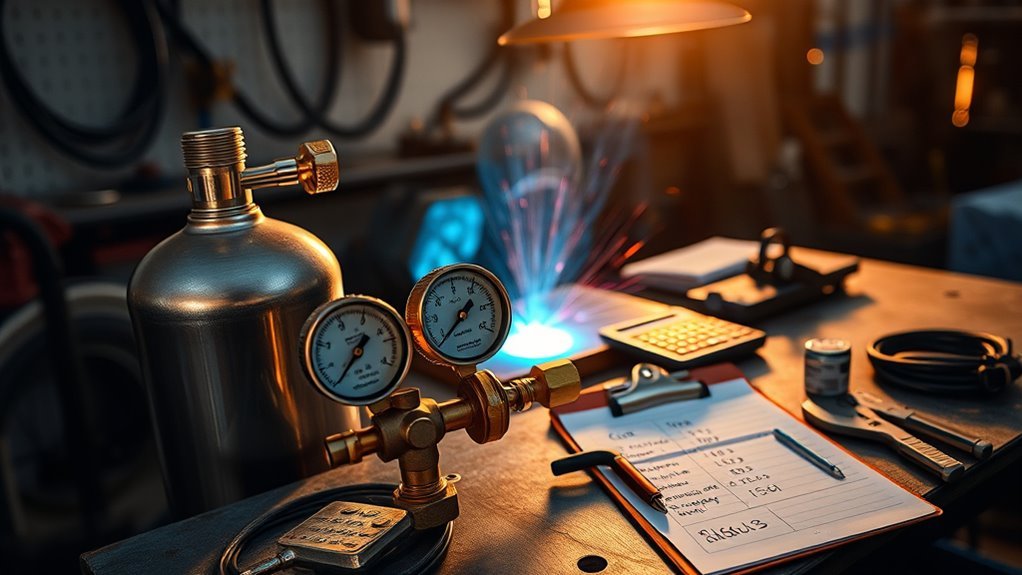
To get precise gas costs, you’ll divide refill price by usable hours based on tank volume and your set flow rate.
Convert that cost-per-hour into cost-per-weld by multiplying by average weld duration, then extrapolate to annual usage to estimate total yearly expense.
Comparing 40, 80, and 125 CF examples shows how tank size and flow drive per-hour and yearly costs.
Tank Volume vs. Flow
When you need to know how much welding gas costs per hour, divide the tank’s usable cubic feet by your flow rate in CFH and then divide the refill price by the resulting hours; for example, an 80 CF tank at 10 CFH yields about 8 hours, so a $70 refill works out to $8.75/hour.
Tank volume vs. flow is the core trade-off: higher flow rates (typical TIG/MIG 10–40 CFH) cut operating hours and raise hourly cost.
Account for tank efficiency—usable cubic feet is less than labeled capacity and pressure gauge readings (full ≈2015 psi, half ≈1000 psi) help estimate remaining gas.
Choose larger tanks to reduce refill frequency and per-hour cost, since refill labor is similar across sizes.
Monitor flow rate for accurate costing.
Total Yearly Expense
If you want a clear hourly gas cost, add your tank purchase to the year’s refill bills, then divide that annual total by the welding hours those refills supply.
Start by listing initial tank cost and scheduled refill costs for the year; that becomes your yearly budget for shielding gas. Use tank volume and your flow rate to convert refills into usable welding hours (e.g., 80 CF at 10 CFH ≈ 8 hours).
For example, a $300 80 CF tank plus $360 in refills equals $660 first-year expense; divide by total hours supplied to get cost per hour.
Track expenses monthly for accurate expense tracking and adjust projections after the first year when only refill costs typically apply.
Cost per Weld Hour
Calculate your gas cost per weld hour by dividing each refill’s price by how long that tank actually lasts at your working flow rate (CFH).
Use the tank cubic feet and your CFH to estimate hours: tank CF ÷ CFH = usable hours. Then refill cost ÷ usable hours = cost per weld hour.
For example, an 80 CF tank at 10 CFH lasting 8 hours with a $70 refill yields $8.75/hour; at 20 CFH it lasts 4 hours, $17.50/hour.
A 125 CF tank at 10 CFH lasting 12 hours with the same refill is about $5.83/hour.
Include prorated tank purchase and recurrent refill costs to assess total cost of ownership.
Optimize welding efficiency and gas conservation to lower hourly expenses.
Signs Your Tank Is Running Low and How to Check Pressure

Although it’s easy to overlook, monitoring tank pressure is the quickest, most cost-effective way to know when you’re running low—check the gauge (full ≈ 2015 psi; half ≈ 1000 psi), feel the tank’s weight for a quick field estimate, and track run-time using flow rate (an 80 CF tank at 10 CFH lasts ~8 hours).
Use a calibrated pressure gauge as part of routine tank maintenance to spot significant drops that signal imminent refill. Visually inspect valves and fittings for leaks; a steady pressure decline without use indicates leakage and wasted cost.
For mixed gases, roll the tank gently before use to reblend contents and avoid performance loss that could raise consumable costs. Keep tanks upright to protect internal components and guarantee accurate pressure readings.
Log operating hours and flow rates to predict refill timing and avoid downtime. Acting on these checks preserves gas, reduces unexpected refill expenses, and keeps welding productivity predictable.
Where to Buy or Refill Welding Gas: Local Suppliers and Online Options

When you need gas, prioritize local suppliers— they typically offer the best refill rates (an 80 CF refill runs about $47–$70) and quicker turnarounds than national chains.
You should establish a relationship with a local supplier because many now only refill cylinders bought from them; that preserves refill access and can lower long-term cost per fill.
Shop several nearby vendors to account for regional price variance and demand-driven markups.
For purchases beyond refills, consider online options for cylinders and delivery. Vendors like Primeweld list competitive cylinder pricing (example: 125 CF C25 at $369 with free delivery) and can be cost-effective if you need a specific size or can’t source a used tank locally.
Used tanks around $100 offer upfront savings but verify hydrostatic test status and valve condition before buying.
Balance refill frequency, transport time, and supplier policies to minimize total ownership and operating costs.
Alternatives to Shielding Gas and Cost-Saving Techniques
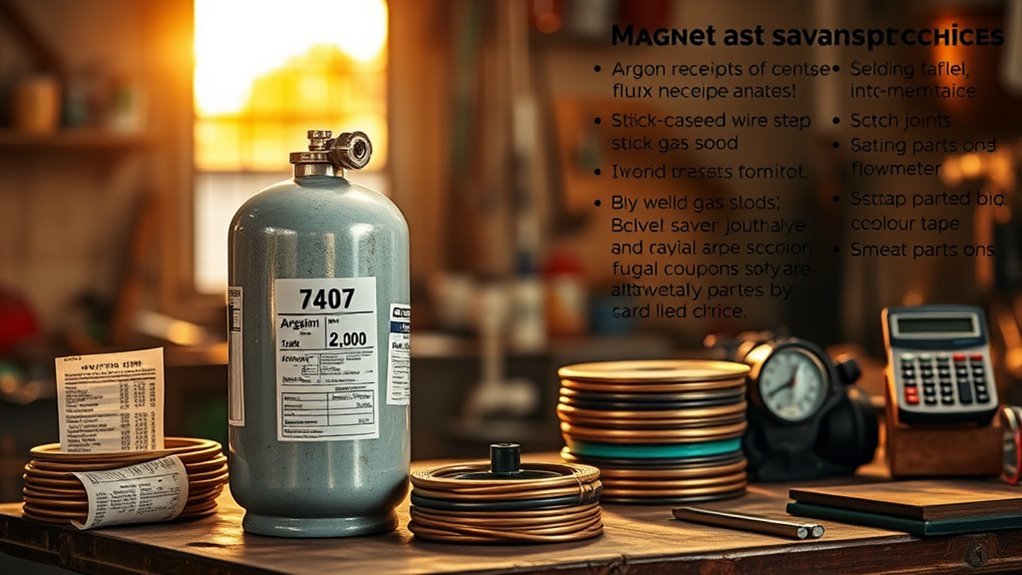
If upfront cost or refill logistics make gas welding impractical for you, there are proven alternatives and tactics to cut shielding-gas expenses.
You can switch to cost effective alternatives like self-shielded flux-cored wire or stick electrodes, both of which eliminate external gas and lower operating costs for many welding project strategies.
Flux-cored works well for MIG setups on dirty or outdoor jobs; stick welding handles thick sections and rough conditions.
- Use self-shielded flux-cored wire to remove gas needs and reduce per-job consumable cost.
- Employ stick (SMAW) for heavy sections where filler cost and portability matter more than finish.
- Reduce gas dependency via larger tank purchases or sourcing used tanks to lower per-CF and upfront spend.
Combine method selection with disciplined workflow—batch similar joints, limit purge waste, and match process to material—to maximize savings without compromising strength or code compliance.
Regional Price Variations and Tips for Getting the Best Deal
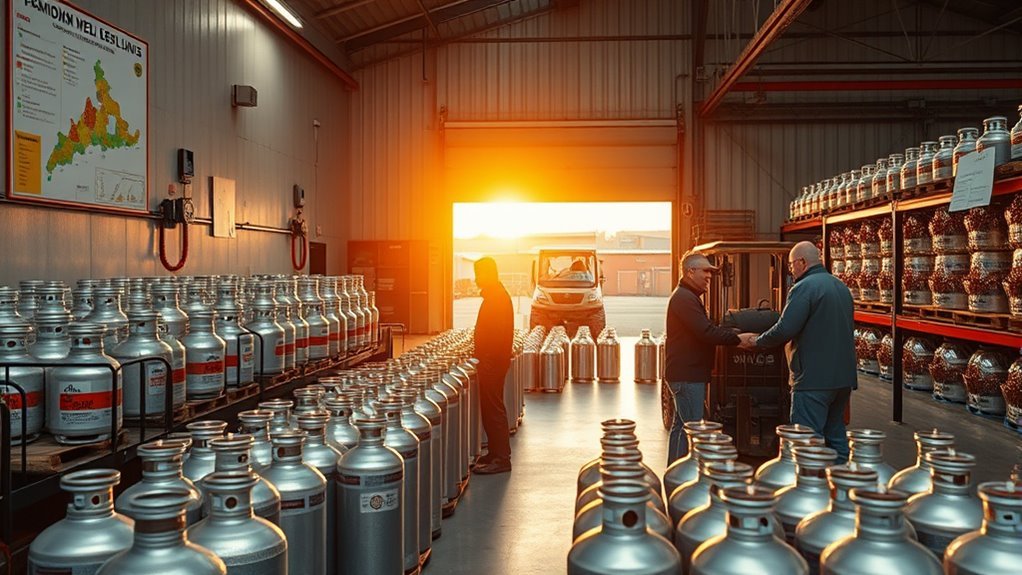
Want the best price on a tank refill? You’ll see wide regional pricing swings: small tanks can be refilled for about $23 in competitive markets, while large 80 CF or 125 CF fills may exceed $70 where demand’s high or suppliers are scarce.
HAZMAT fees further raise costs—expect roughly $38 for a 20 lb CO2 refill and up to $265 for two T-size Argon/C25 fills in some areas.
To reduce spend, compare local independent suppliers against national chains; independents often undercut chains due to lower overhead.
Leverage supplier competition by requesting written quotes and asking about bundled refill discounts or HAZMAT waivers for frequent customers.
Establish an account with a preferred local supplier to secure volume pricing, priority service, and clearer billing.
Monitor regional pricing trends and rotate suppliers if you see better offers. That targeted approach minimizes cost per fill while maintaining supply reliability.
Frequently Asked Questions
Can Welding Gas Tanks Be Shipped Internationally and What Are the Regulations?
Yes — you can ship welding gas cylinders internationally, but you’ll follow strict international shipping and gas cylinder regulations, packaging, labeling, documentation, carrier rules, and hazardous materials fees; noncompliance risks fines, delays, and refused transit.
Can I Exchange an Empty Tank at a Scrap Metal Yard for Credit?
Yes—you can often exchange an empty tank at a scrap metal yard for credit, but scrap value depends on tank condition, steel weight, fittings removed, and local metal prices; expect modest credit, paperwork, and safety checks.
How Do Impurities or Moisture Affect Welding Gas Performance?
Impurities and moisture degrade weld quality, reducing arc stability and strength; you’ll face higher scrap rates and rework costs. Maintain gas purity and moisture control with proper filtration, dryers, and sealed storage to minimize expense and defects.
Are There Insurance Requirements for Storing Multiple Gas Cylinders?
Yes — you’ll need insurance policies covering gas cylinder storage, liability, and fire. Insurers often mandate ventilated, secured storage, separation of incompatible gases, capacity limits and inspection records; noncompliance raises premiums or voids coverage.
Can Household Propane Regulators Be Used With Welding Tanks?
No — you shouldn’t use household propane regulators with welding tanks. Propane compatibility differs; welding safety requires regulators rated for oxy-fuel mixes, correct pressures, and certifications. Using wrong regulators risks leaks, equipment damage, and fines.
Conclusion
When it comes to welding gas costs, remember “penny wise, pound foolish”: shop smart. Compare local suppliers vs. chains, weigh purchase vs. lease, and match tank size and gas type to your workload to avoid overspending. Track refill frequency and calculate cost per welding hour to budget accurately. Use alternatives like flux-cored wire for low-shield needs, bundle refills, and negotiate rates to cut ongoing expenses without sacrificing productivity.


